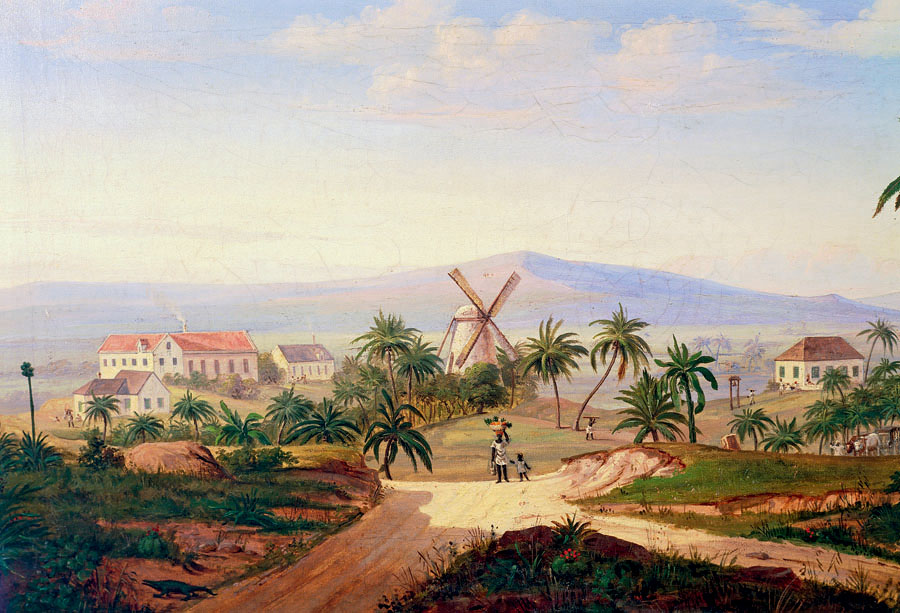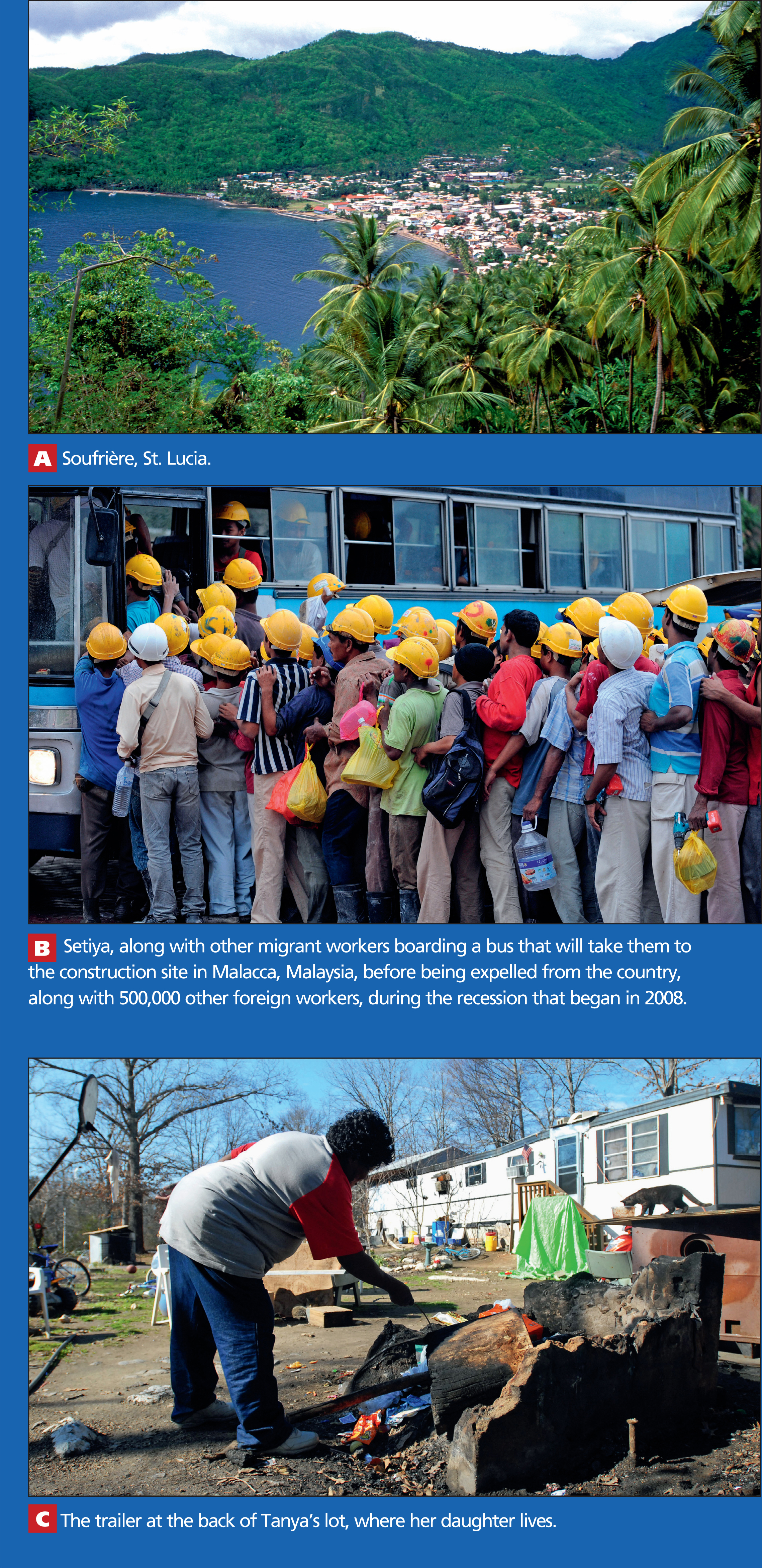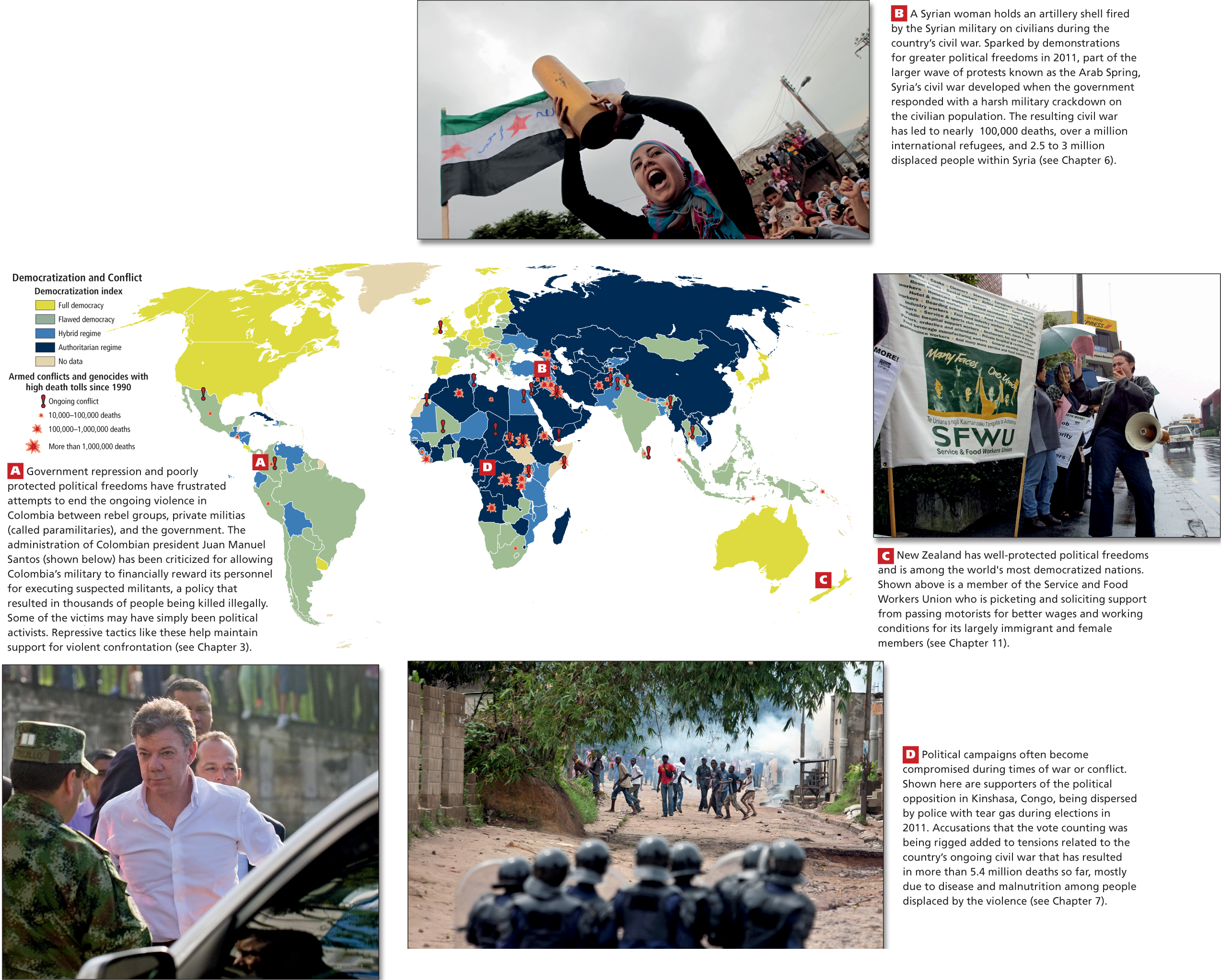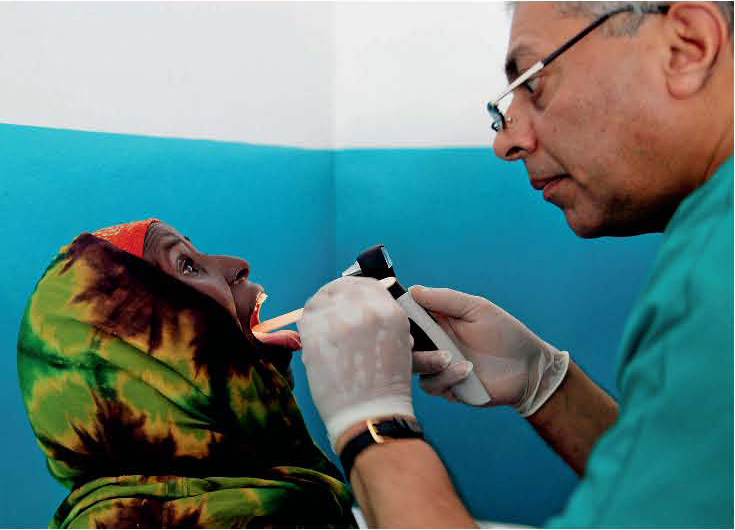1.5 Globalization, Power, and Politics
interregional linkages economic, political, or social connections between regions, whether contiguous or widely separated
globalization the growth of interregional and worldwide linkages and the changes these linkages are bringing about
What Is the Global Economy?
Geographic Insight 5
Globalization and Development: Increased global flows of information, goods, and people are transforming patterns of economic development.
global economy the worldwide system in which goods, services, and labor are exchanged
European colonization was an early expansion of globalization. Starting in about 1500 c.e., European countries began extracting resources from distant parts of the world that they had conquered. The colonizers organized systems to process those resources into higher-value goods to be traded wherever there was a market. Sugarcane, for example, was grown on Caribbean and Brazilian plantations with slave labor from Africa (Figure 1.16) and made locally into crude sugar, molasses, and rum. It was then shipped to Europe and North America, where it was further refined and sold at considerable profit. The global economy grew as each region produced goods for export, rather than just for local consumption. At the same time, regions also became increasingly dependent on imported food, clothing, machinery, energy, and knowledge.

The new wealth derived from the colonies, and the ready access to global resources led to Europe’s Industrial Revolution. No longer was one woman producing the cotton or wool for clothes by spinning thread, weaving the thread into cloth, and sewing a garment. Instead, these separate tasks were spread out among many workers, often in distant places, with some people specializing in producing the fiber and others in spinning, weaving, or sewing. These innovations in efficiency were followed by labor-saving improvements such as mechanized reaping, spinning, weaving, and sewing.
This larger-scale mechanized production accelerated globalization, as it created a demand for raw materials and a need for markets in which to sell finished goods. European colonizers managed to integrate the production and consumption of their colonial possessions in the Americas, Africa, and Asia. For example, in the British Caribbean colonies, hundreds of thousands of enslaved Africans wore rough garments made of cheap cloth woven in England from cotton grown in British India. The sugar that slaves produced on British-owned plantations with iron equipment from British foundries was transported to European markets in ships made in the British Isles of trees and resources from the North American colonies and other parts of the world.
multinational corporation a business organization that operates extraction, production, and/or distribution facilities in multiple countries
Workers in the Global Economy
VIGNETTE
Sixty-year-old Olivia lives near Soufrière on St. Lucia, an island in the Caribbean (Figure 1.17A). She, her daughter Anna, and her three grandchildren live in a wooden house surrounded by a leafy green garden dotted with fruit trees. Anna has a tiny shop at the side of the house, from which she sells various small everyday items and preserves that she and her mother make from the garden fruits.
On days when the cruise ships dock, Olivia heads to the market shed on the beach with a basket of homegrown goods. She calls out to the passengers as they near the shore, offering her spices and snacks for sale. In a good week she makes U.S.$50. Her daughter makes about U.S.$100 per week in the shop and is constantly looking for other ways to earn a few dollars.
Olivia and Anna support their family of five on about U.S.$170 a week (U.S.$8840 per year). From this income they take care of their bills and other purchases, including school fees for the granddaughter who will go to high school in the capital next year and perhaps college if she succeeds. Their livelihood puts them at or above the standard of living of most of their neighbors.
In Malacca, Malaysia, 30-year-old Setiya, an illegal immigrant from Tegal, Indonesia, is boarding a bus that will take him to a jobsite where he is helping build a new tourist hotel (see Figure 1.17B). Like a million other Indonesians attracted by the booming economy, he snuck into Malaysia, risking arrest, because in Malaysia average wages are four times higher than at home.
This is Setiya’s second trip to Malaysia. His first trip was to do work legally on a Malaysian oil palm plantation. Upon arrival, however, Setiya found that he would have to work for 3 months just to pay off his boat fare from Indonesia. Not one to give in easily, he quietly went to another city and found a construction job earning U.S.$10 a day (about U.S.$2600 a year), which allowed him to send money home to his family in Indonesia.
In 2008, Malaysia announced it was expelling 500,000 foreign workers; Setiya was one of them. The country was suffering from growing unemployment due to the global recession, and its leaders wanted to save more jobs for locals by expelling foreign workers. When the recession is alleviated, young fathers from Indonesia (like Setiya) may once again risk trips on leaky boats to illegally enter Malaysia and Singapore in order to support their families.
Fifty-year-old Tanya works at a fast-food restaurant outside of Charleston, South Carolina, making less than U.S.$7.50 an hour. She had been earning U.S.$8 an hour sewing shirts at a textile plant until it closed and moved to Indonesia. Her husband is a delivery truck driver for a snack-food company.
Between them, Tanya and her husband make $30,000 a year, but from this income they must cover all their expenses, including mortgage, gasoline, and car payments. In addition, they help their daughter, Rayna, who quit school after eleventh grade and married a man who is now out of work. They and their baby live at the back of the lot in an old mobile home (see Figure 1.17C).
With Tanya’s now-lower wage (almost $1000 less a year), there will not be enough money to pay the college tuition for her son, who is in high school. He had hoped to become an engineer, and would have been the first in the family to go to college. For now, he is working at the local gas station.
These people, living worlds apart, are all part of the global economy. Workers around the world are paid startlingly different rates for jobs that require about the same skill level. Varying costs of living and varying local standards of wealth make a difference in how people live and regard their own situation. Though Tanya’s family has the highest income by far, compared to their neighbors they live in poverty, and their hopes for the future are dim. Olivia’s family, on the other hand, are not well off, but they do not think of themselves as poor because they have what they need, others around them live in similar circumstances, and their children seem to have a future. They can subsist on local resources, and the tourist trade promises continued cash income. But their subsistence depends on circumstances beyond their control; in an instant, the cruise-line companies can choose another port of call. Setiya, by far the poorest, seems trapped by his status as an illegal worker, which robs him of many of his rights. Still, the higher pay that he can earn in Malaysia offers him a possible way out of poverty. [Source: From Lydia Pulsipher’s and Alex Pulsipher’s field notes. For detailed source information, see Text Credit pages.] 

Thinking Geographically

Question
(Photo A) What about this photo might suggest that Olivia and her neighbors share a similar standard of living?
A. B. C. D. 
Question
(Photo B) What about this photo suggests that Setiya is a low-paid worker?
A. B. C. D. 
Question
(Photo C) How does this photo suggest that Rayna, Tanya's daughter, has a low income?
A. B. C. D.
The Debate over Globalization and Free Trade
free trade the unrestricted international exchange of goods, services, and capital
These and other forms of trade protection are subjects of contention. Proponents of free trade argue that the removal of all tariffs and quotas encourages efficiency, lowers prices, and gives consumers more choices. Companies can sell to larger markets and take advantage of mass-production systems that lower costs further. As a result, businesses can grow faster, thereby providing people with jobs and opportunities to raise their standard of living. These pro–free trade arguments have been quite successful, and in recent decades, restrictions on trade imposed by individual countries have been greatly reduced. Several regional trade blocs have been formed; these are associations of neighboring countries that agree to lower trade barriers for one another. The main ones are the North American Free Trade Agreement (NAFTA), the European Union (EU), the Southern Common Market in South America (Mercosur), and the Association of Southeast Asian Nations (ASEAN).
World Trade Organization (WTO) a global institution made up of member countries whose stated mission is the lowering of trade barriers and the establishment of ground rules for international trade
living wages minimum wages high enough to support a healthy life
ON THE BRIGHT SIDE
Reforms at the IMF and World Bank
In response to the now widely recognized failures of SAPs, and the overemphasis on the power of markets to guide development, the IMF and the World Bank have made some changes. SAPs have been replaced with “Poverty Reduction Strategy Papers,” or PRSPs. Each country in need works with World Bank and IMF personnel to design a broad-based plan for both economic growth and poverty reduction. PRSPs still push market-based solutions and aim toward reducing the role of government in the economy. These programs remain highly bureaucratic, but they do focus on poverty reduction rather than just “development via structural adjustment” per se. They promote the maintenance of education, health, social services, and broader participation in civil society. PRSPs also include the possibility that all or some of a country’s debt be “forgiven” (written off by the IMF and the World Bank), thus alleviating one of the worst side effects of SAPs—debt that bankrupts that country—that has stopped progress in poor countries and, by 2011, began to affect even developed countries in Europe such as Greece, Italy, Ireland, Spain, and Portugal.
In October 2011, activists around the world joined what was dubbed the Occupy Wall Street movement, protesting what they saw as the downside of free trade: the growing disparity of wealth worldwide and the unfettered role of global financial institutions, commodity speculators, and the superrich in molding the global economy to suit their ends. Labeling the superrich the “1 percent” and the rest of the world’s population the “99 percent,” the “Occupy” demonstrations spread throughout Europe and to hundreds of cities in Asia, Africa, Europe, Oceania, and the Americas.
fair trade trade that values equity throughout the international trade system; now proposed as an alternative to free trade
In evaluating free trade, globalization, and fair trade, consider how many of the things you own or consume were produced in the global economy—your computer, clothes, furniture, appliances, car, and foods. These products are cheaper for you to buy, and your standard of living is higher as a result of lower production costs as well as competition among many global producers. However, you or someone you know may have lost a job because a company moved to another location where labor and resources are cheaper. Underpaid workers (even children) working under harsh conditions that possibly generate high levels of pollution may have made those cheap products. If workers can’t earn living wages, often some family members end up migrating, perhaps without the proper papers, to earn a better wage. Given all these factors, consider the advantages and drawbacks of both free trade and fair trade.
THINGS TO REMEMBER
 Globalization encompasses many types of worldwide and interregional flows and linkages, especially the ways in which goods, capital, labor, and resources are exchanged among distant and very different places.
Globalization encompasses many types of worldwide and interregional flows and linkages, especially the ways in which goods, capital, labor, and resources are exchanged among distant and very different places. Geographic Insight 5Globalization and Development Throughout the world, globalization is transforming patterns of economic development as local self-sufficiency is giving way to global interdependence and international trade.
Geographic Insight 5Globalization and Development Throughout the world, globalization is transforming patterns of economic development as local self-sufficiency is giving way to global interdependence and international trade. Under true free trade, all economic transactions are conducted without interference or regulation in an open marketplace. Under fair trade, an alternative to free trade, consumers are asked to pay a fair price to producers, and producers are expected to pay living wages and uphold environmental and safety standards in the workplace.
Under true free trade, all economic transactions are conducted without interference or regulation in an open marketplace. Under fair trade, an alternative to free trade, consumers are asked to pay a fair price to producers, and producers are expected to pay living wages and uphold environmental and safety standards in the workplace.
1.5.1 Power and Politics
democratization the transition toward political systems guided by competitive elections
authoritarianism a political system that subordinates individual freedom to the power of the state or of elite regional and local leaders

Thinking Geographically
After you have read about power and politics, you will be able to answer the following questions:

Question
(Photo A) Why has Juan Manuel Santos' relationship with the Colombian military come under criticism?
A. B. C. D. 
Question
(Photo B) Why is the participation of women in the Arab Spring significant?
A. B. C. D. 
 ,
, 
Question
(Photos C, D) Of the factors mentioned in the text as necessary for democracy to flourish, which are obviously present in (C) and missing in (D)?
A. B. C. D.
Geographers do not necessarily conclude that democracy is the “best” system of government. Indeed, many geographers are critical of the imposition of democracy, often by foreign governments or organizations, in places where long-standing cultural traditions support other political arrangements. They say that a democratic form of government should be achieved democratically. Nevertheless, few would deny that the shift toward more democratic systems of government over the past century and into recent times has been extremely significant, if not always peaceful. In this regard, geographers and other scholars are particularly interested in the role of democracy at the state and local levels, in addition to the roles that social movements, international organizations, and a free media play in democratization.  23. PROMOTING DEMOCRACY: A CONTROVERSIAL THEME
23. PROMOTING DEMOCRACY: A CONTROVERSIAL THEME
The Expansion of Democracy
Geographic Insight 6
Power and Politics: There are major differences across the globe in the ways that power is wielded in societies. Modes of governing that are more authoritarian are based on the power of the state or community (or tribal) leaders. Modes that are more democratic give the individual a greater say in how policies are developed and governments are run. There are also many other ways of managing political power.
The twentieth century saw a steady expansion of democracy throughout the world, with more and more countries holding elections of their leaders—at least at the national level. While democracy has become an ideal to which most countries aspire, there is little agreement about just what constitutes democratic institutions. Can the principles of a specific religion be part of democratic constitutions? Is it possible to have democratic government at the national level but quite authoritarian rule at the local level? What about forms of democratic participation other than voting, such as the ability to speak openly to leaders, to protest, to lobby for or against particular laws (Figure 1.18A)? Are not these also essential components of democracy? The Arab Spring movements, which commenced in early 2011 in a number of countries in North Africa and Southwest Asia, demonstrated that popular will can achieve amazing turnovers of power, as was the case in Tunisia, Egypt, and Libya. However, in Egypt in the 2012 elections, the Muslim Brotherhood—a male-dominated Islamist political party with authoritarian leanings—won an easy majority, causing concern that voters had quashed broader democratic reforms. Popular uprisings don’t always work well, smoothly, or at all (see Figure 1.18B, D). In Syria, Bahrain, and Yemen, where opposition demonstrations against authoritarian regimes also began early in 2011, the bloodshed continued for more than a year—and who shall ultimately have power remains unresolved. In all six of these countries, only time will tell if activists, unfamiliar with marshalling broad-based political will, can design systems that satisfy enough people to create a calm interim during which these governing systems can be refined peacefully.
What Factors Encourage Successful Democratization?
civil society the social groups and traditions that function independently of the state and its institutions to foster a sense of unity and informed common purpose among the general population
- Peace: Peace is essential to creating an environment in which “free and fair” elections can take place.
- Broad prosperity: As a broader segment of the population gains access to more than the bare essentials of life, there is generally a shift toward freer elections, which put more power in the hands of citizens. Whether general prosperity must be in place before truly stable democracy can be established is still widely debated, as is the question of whether prosperity necessarily leads to democracy.
- Education: Better-educated people tend to want a stronger voice in how they are governed. Although democracy has spread to countries with relatively undereducated populations, leaders in such places sometimes become more authoritarian once elected.
- Civil society: The social groups and traditions that function independently of the state and its institutions can foster a sense of unity and informed common purpose among the general population. Civil society institutions can include the media, nongovernmental organizations (NGOs; discussed below and in Figure 1.19), political parties, universities, unions, community service organizations such as Rotary and Lions clubs, and in some cases, religious organizations (see Figure 1.18C).

Courtesy The Times/Gallo Images/Getty Images
Democratization and Geopolitics
geopolitics the strategies that countries use to ensure that their own interests are served in relations with other countries
capitalism an economic system based on the private ownership of the means of production and distribution of goods, driven by the profit motive and characterized by a competitive marketplace
communism an ideology, based largely on the writings of the German revolutionary Karl Marx, that calls on workers to unite to overthrow capitalism and establish an egalitarian society in which workers share what they produce; as practiced, communism was actually a socialized system of public services and a centralized government and economy in which citizens participated only indirectly through Communist Party representatives
The Cold War became a race to attract the loyalties of unallied countries and to arm them. Sometimes the result was that unsavory dictators were embraced as allies by one side or the other. Eventually, the Cold War influenced the internal and external policies of virtually every country on Earth, often oversimplifying complex local issues into a contest of democracy versus communism.
ethnic cleansing the deliberate removal of an ethnic group from a particular area by forced migration
genocide the deliberate destruction of an ethnic, racial, or political group
The new geopolitical era ushered in by the terrorist attacks on the United States on September 11, 2001, is still evolving. Because of the size and the global power of the United States, the attacks and the U.S. reactions to them affected virtually every international relationship, public and private. The ensuing adjustments, which will continue for years, are directly or indirectly affecting the daily lives of billions of people around the world.
International Cooperation
So far there has been no serious effort to engage the principles and practices of democratization at the global scale. However, many aspects of globalization favor international cooperation over national self-interest.
The prime example today of international cooperation is the United Nations (UN), an assembly of 193 member states. The member states sponsor programs and agencies that focus on economic development, general health and well-being, democratization, peacekeeping assistance in “hot spots” around the world, humanitarian aid, and scientific research. Thus far, various countries have been unwilling to relinquish sovereignty, the right of a country to conduct its internal affairs as it sees fit without interference from outside. Consequently, the United Nations has limited legal authority and often can enforce its rulings only through persuasion. Even in its peacekeeping missions, there are no true UN forces. Rather, troops from member states wear UN designations on their uniforms and take orders from temporary UN commanders.
United Nations (UN) an assembly of 193 member states that sponsors programs and agencies that focus on economic development, security, general health and well-being, democratization, peacekeeping assistance in “hot spots” around the world, humanitarian aid, and scientific research
Nongovernmental organizations (NGOs) are an increasingly important embodiment of globalization. In such associations, individuals, often from widely differing backgrounds and locations, agree on political, economic, social, or environmental goals. For example, some NGOs, such as the World Wildlife Fund, work to protect the environment. Others, such as Doctors Without Borders, provide medical care to those who need it most, especially in conflict zones. The Red Cross and Red Crescent provide emergency relief after disasters, as do Oxfam and Catholic Charities and Gift of Givers (Figure 1.19). The educational efforts of an NGO such as Rotary International can raise awareness among the global public about important issues such as childhood vaccinations.
nongovernmental organizations (NGOs) associations outside the formal institutions of government in which individuals, often from widely differing backgrounds and locations, share views and activism on political, social, economic, or environmental issues
NGOs can be an important component of civil society, yet there is some concern that the power of huge international NGOs might undermine democratic processes, especially in small, poor countries. Some critics feel that NGO officials are a powerful, do-gooder elite that does not interact sufficiently well with local people. A frequent target of such criticism is Oxfam International (a networked group of 17 NGOs), the world leader in emergency famine relief. Oxfam was a major provider of relief after the 2004 Indian Ocean tsunami and the 2010 Haiti earthquake. It has now expanded to cover long-term efforts to reduce poverty and injustice, which Oxfam sees as the root causes of famine. This more politically active role has brought Oxfam into conflict with local officials and with WTO policies on trade. The wisest NGOs solicit input from a wide range of individuals and organizations—a feature that political scientists consider essential to building civil society.  22. NGOs PLAY LARGER ROLE IN WORLD AFFAIRS
22. NGOs PLAY LARGER ROLE IN WORLD AFFAIRS
THINGS TO REMEMBER
 Democratization is the transition toward political systems that are guided by competitive elections and other forums in which individuals can have a greater voice in policy formation and in how their governments are run.
Democratization is the transition toward political systems that are guided by competitive elections and other forums in which individuals can have a greater voice in policy formation and in how their governments are run. Democratic systems are gradually replacing many authoritarian regimes worldwide, but the result of this apparent trend is unknown.
Democratic systems are gradually replacing many authoritarian regimes worldwide, but the result of this apparent trend is unknown. Geographic Insight 6Power and Politics Peace, broad prosperity, education, and civil society are among the most widely agreed-upon factors necessary for democratization to flourish.
Geographic Insight 6Power and Politics Peace, broad prosperity, education, and civil society are among the most widely agreed-upon factors necessary for democratization to flourish. Increasingly, the type of government that a country decides upon is of geopolitical significance in that official international organizations, trade associations, and NGOs from other countries have a stake in the decision and may try to influence it.
Increasingly, the type of government that a country decides upon is of geopolitical significance in that official international organizations, trade associations, and NGOs from other countries have a stake in the decision and may try to influence it.